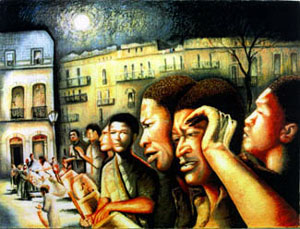Candombe
Marie Trigona writes in her article, "Uruguay Spirit of Afro Resistance Alive in Candombe" from Upside Down World, Marie Trigona (a writer, radio producer and filmmaker based in Buenos Aires) reports: In the streets of Montevideo, Uruguay, Afro-Uruguayans celebrate an often-ignored part of their history - Candombe and resistance. For more than 200 years Afro descendants have maintained the tradition of Candombe, a rhythm that traveled from Africa to Uruguay
The word Candombe literally means "place and dance of Africans." The musical tradition evolved during the colonial era. Africans brought to Uruguay
Today the music thrives in Montevideo Montevideo Montevideo Montevideo
Origins of Candombe
In whatever time their white masters allowed, slaves communicated through drums and dance. The first Llamadas took place at this time. Some historians assert that the word Llamadas - "parade of calls," refers to the drums Africans played to call out to each other in their homes. Each tribe had a particular rhythm that could be identified from afar.
Within these living quarters, African musicians gave birth to a rhythm and tradition which has been passed on for generations. Martin Silva is a young musician from Montevideo 's Barrio Sur.
Upper class whites tried to ban Candombe gatherings in the 19th century. One of the earliest historical documents tracing Candombe music is an 1808 police record, when citizens of Montevideo
"We can't refer to anything before 1900 with historical certainty," explains Navos. There exists an extensive historical void regarding Candombe practices between 1800 and 1900. "What exists today is what we could hide and preserve, which has led to the transformation of Candombe in what it is today, from generation to generation," he continues.
"Barrio Sur and Palermo Africa mixed with Catholicism." Many historians assert that the first Llamadas took place in clandestine music halls, until they went public with the abolishment of slavery in the late 19th century. "The first Llamadas held was a procession from the Meat curing plants toward Montevideo
The dance and music are filled with symbols of African descendants' painful past. The troupes the perform the Llamadas are called comparsas, and are made up of cuerdas (drummers) and dancers. The drummers walk very slowly, barely separating their feet as they walk. This rhythm and style of procession is meant to symbolize Afro-descendants' past and historical roots when their ancestors were made to walk with chains and shackles.
Three main characters lead the llamadas: the Mama Vieja (Grandmother), Gramillero (Old Doctor), and Escobero (Wizard). The Gramillero walks with a cane as if he's about to fall over. The Mama Vieja carries an umbrella attending to the Grammillero. The Escobero sweeps the ground with a great baton.
Navos describes the significance of these three characters. "The Escobero, I don't know if he's a magician or wizard, he's the person in charge of taking charge of the spirit of the comparsa. The Escobero walks in front of the flags to clean the bad spirits opening the way for the comparsa."
Some of the city's Candombe troops feature more than 50 drummers and dozens of dancers. Each neighborhood has its own rhythm and style. In Barrio Sur, where slaves took the music underground in the 19th century, new Candombe troops are emerging today.
According to Mario Suarez a young musician playing a traditional African drum in the Isla de Flores comparsa, the Llamadas is more than a performance. "The Llamadas and Candombe for the Afro descendants are a passion and a tradition. We have to maintain the tradition. The identity of the comparsa of Isla de Flores is strong, because it's part of the identity barrio Ansinas and Barrio Sur. Sur.
Today Afro-Uruguayans number around 100,000, or about 6 percent of the population. For many Uruguayans of Afro descent, Candombe is part of everyday life and resistance in a continually discriminating society. The Llamadas ispracticed all year long, not just during Carnival. Uruguayans have also adopted the increasingly popular Candombe music as part of their national identity. Especially in the past 30 years, the music has influenced White musicians. The music was used to express resistance to the repressive regime during Uruguay Montevideo but has spread to Uruguay 's interior and echoes in Argentina
"Candombe is not only a question of skin color, it's a way of thinking and being," says Diego Bonga Martinez from the Afro-cultural movement in Buenos Aires Buenos Aires Martinez Montevideo
















No comments:
Post a Comment